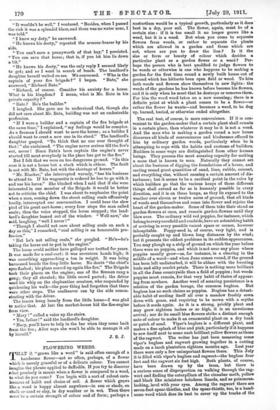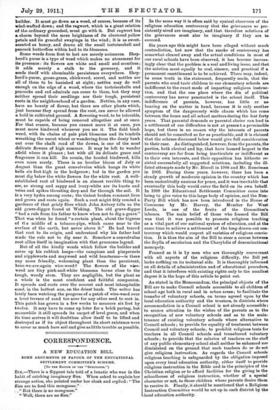FLOWERING WEEDS.
THAT "grows like a weed" is said often enough of a handsome flower—not so often, perhaps, of a flower which is merely graceful or of a delicate colour. You cannot imagine the phrase applied to daffodils. If you try to discover Iihat precisely is meant when a flower is compared to a weed, to what do you come ? You begin with a sort of robust care- lessness of habit and choice of soil. A flower which grows like a weed is happy almost anywhere—in sun or shade, on chalk or sand or clay, in dry weather or in wee. Then there must be a certain strength of colour and of form; perhaps a nasturtium would be a typical growth, particularly as it does best in a dry, poor soil. The flower, again, must be of a certain size : if it is too small it no longer grows like a weed, but it is a weed. But when you come to separate flowers from weeds, or rather to separate the plants which are allowed in a garden and those which are not, where are you to draw the line ? Is it the size or form or beauty of colour which decides a particular plant as a garden flower or a weed Per- haps the person who is best qualified to judge flowers to be weeds or otherwise is one who happens to be making a garden for the first time round a newly built house out of ground which has hitherto been open field or wood. To him both weeds and flowers show themselves in new lights : the weeds of the gardens he has known before become his flowers, and it is only when he must that he destroys or removes them. For him the word weed takes on a new meaning; there is a definite point at which a plant ceases to be a flower—or rather the flower he wants—and becomes a weed, to be dug up, burned, buried, or otherwise ended altogether.
The real test, of course, is mere convenience. If it is con- venient to the garden-maker that a certain plant shall remain in a certain place, then whatever it may be it is not a weed. And the man who is making a garden round a new house discovers all kinds of conveniences and kindnesses offered to him by ordinary garden weeds, particularly when he is attempting to cope with the habits and customs of builders. Builders in some ways are distinguished from other human beings. They possess the most amazing capacity for making a mess that is known to man. Naturally they cannot set about the business of digging the foundations of a house, and carting round great quantities of sand, lime, rubble, cement, and everything else, without causing a certain amount of dis- turbance; but it seems to be a cardinal point in the rules by which builders go that the various heaps of these different things shall extend as far as is humanly possible in every direction, and it is on these heaps, as they lie exposed to the weather over eleven or twelve acres of ground, that all kinds of weeds seed themselves and come into flower and rejoice the heart of the garden-maker. Some of them take their stand as garden-flowers at once, and remain garden-flowers until they blow over. The ordinary wild red poppies, for instance, which belong to every cornfield and roadside, have an astonishing habit of arriving in every possible vacant space or corner, however inhospitable. Poppy-seed is, of course, very light, and is probably caught up and blown long distances by the wind; but it presents the oddest problems in its sudden appearances. You may plough up a strip of ground on which the year before there were no poppies, and which is not near any place where poppies usually grow—as, for instance, in a clearing in the middle of a wood—and when June comes round, if the ground has been left undisturbed, it will be ablaze with the bursting buds and silky scarlet petals. There is nothing more brilliant in all the June countryside than a field of poppies ; but weeds poppies must remain, for that very habit of theirs of appear- ing from nowhere. Another weed of amazing persistence is a relation of the garden borage, the common bugloss. But bugloss has no such claims as poppies. Bugloss has a detest- able habit of seeding itself all over a meadow freshly sown down with grass, and requiring to be mown with a scythe before it seeds again. As it is a strong, prickly plant and may grow eighteen inches or so high, it is an unwelcome arrival; nor do its small blue flowers strike a distinct enough note of colour to make it an ornamental plant on a dry bank or patch of sand. Viper's bugloss is a different plant, and makes a fine splash of blue and pink, particularly if it happens to sow itself next to some such brilliant yellow flowers as those of the ragwort. The writer has just been measuring some viper's bugloss and ragwort growing together in a cutting made on a larch plantation eighteen months ago. Last year there were only a few unimportant flowers there. This July it is filled with viper's bugloss and ragwort—the bugloss four feet and the ragwort six feet high. Both plants, of course, have been drawn up by the trees, but there is a curious sense of disproportion on walking through the rag- wort and finding the caterpillars of the cinnabar moth, yellow and black like miniature heloderm lizards, and as poisonous- looking, level with your eyes. Among the ragwort there are seven-foot spear-thistles, and the spear-thistle, too, is a hand- some weed which does its best to cover up the hacks of the
builder. It must go down as a weed, of course, because of its wind-wafted down; and the ragwort, which is a giant relation of the ordinary groundsel, must go with it. But ragwort has a charm beyond the mere brightness of its clustered yellow petals and its graceful swayings in the wind ; it is as sweet- scented as honey, and draws all the small tortoiseshell and peacock butterflies within hail to its blossoms.
Some weeds from first to last are merely nuisances. Shep- herd's purse is a type of weed which makes no atonement for its presence : its flowers are white and small and scentless ; it adds merely a stalk to the greenery, and it seeds itself with abominable persistence everywhere. Shep- herd's-purse, goose-grass, chickweed, sorrel, and nettles are all of them to be banished at sight ; nettles may do well enough on the edge of a wood, where the tortoiseshells and peacocks and red admirals can come to them, but they may neither spread their seedlings nor their tough, persistent roots in the neighbourhood of a garden. Nettles, in any case, have no beauty of flower, but there are other plants which, just because they spread from the root, can never be allowed a hold in cultivated ground. A flowering weed, to be tolerable, must be capable of being removed altogether and at once. For that reason, because you cannot move it at once, you must move bindweed whenever you see it. The field bind- weed, with its chains of pale pink blossoms and its tendrils wreathing the uncut wheat or wandering from the dusty bank out over the chalk road of the downs, is one of the most delicate flowers of high summer. It may be left to wander afield where it pleases ; but with all its delicate grace and fragrance it can kill. Its cousin, the hooded bindweed, kills even more surely. There is no lovelier bloom of July or August than the great convolvulus which hangs its white bells six feet high in the hedgerow; but in the garden you must dig below the white flowers for the white root. A well- established root of bindweed is an almost terrible thing to see, so strong and sappy and ivory-white are its knots and veins and spikes thrusting deep and far through the soil. It is a very hydra among roots; the tiniest broken remnant lives and grows and roots again. Such a root might fitly remind a gardener of that grisly fibre which John Aubrey tells us the old grave-digger found. at Woking. The old grave-digger "had a rule from his father to know when not to dig a grave." That was when he found " a certain plant, about the bigness of tl.e middle of a tobacco-pipe, which came near to the surface of the earth, but never above it." He had traced that root to its origin, and understood why his father had made the rule not to dig near it. Somehow a convolvulus root allies itself in imagination with that gruesome legend.
But of all the kindly weeds which follow the builder and cover up his rubbish heaps—the tampions and pimpernels and nippleworts and mayweed and wild heartsease—is there any more friendly, welcoming plant than the persistent, here-we-are-again wire-weed? The flowers of the wire- weed are tiny pink-and-white blossoms borne close to the tough, woody stem. They are negligible, but the plant as a whole is the most confident and faithful companion. It spreads and roots over the sourest and most inhospitable sand, in the hottest sun, on the driest bank. The writer has lately been watching the progress of a patch of wire-weed over a level termee of sand too sour for any other seed to root in. This patch has grown in a few weeks to measure six feet by twelve. It may have to come up later for a brick paving, but meanwhile it still spreads its carpet of level green, and when its time arrives it will doubtless allow itself to be lifted and destroyed as if its object throughout its short existence were to cover as much bare soil and give as little trouble as possible.







































 Previous page
Previous page